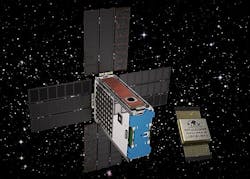CubeSat designers choose radiation-hardened NAND Flash memory from DDC for NASA BioSentinel space project
BOHEMIA, N.Y. – Space flight computer experts at the Space Dynamics Laboratory at Utah State University in North Logan, Utah, needed radiation-hardened high-density NAND Flash memory for the Pearl single-board computer they designed for the NASA BioSentinel CubeSat spacecraft. They found their solution from Data Device Corp. (DDC) in Bohemia, N.Y.
The Pearl single-board computer is to be used as the flight computer on the NASA BioSentinel CubeSat satellite space mission to study the effects of solar radiation on organisms.
The Pearl computer board, along with DDC's Flash memory, is baselined for use on several different upcoming missions for NASA and the U.S. Department of Defense (DOD).
BioSentinel CubeSat will deploy as part of the first flight of the Space Launch System (SLS) -- the largest rocket ever developed, and will enable astronauts to explore destinations far into the solar system.
Related: Space: the next frontier of rad-hard
DDC's 192-gigabit NAND Flash provides the CubeSat spacecraft with compact high-density memory to enable the satellite's use of triple modular redundancy (TMR) error correction for operation without failure, DDC officials say.
The NAND Flash uses radiation-mitigation RAD-PAK technology that provides spot shielding against space radiation. RAD-PAK enables DDC to deliver the latest commercially available microelectronics in a space-qualified package, providing designers with high-performance space-grade solutions at affordable costs.
RAD-PAK-based space solutions offer a total dose immunity of 100 kilorads or higher, and have been qualified by NASA, ESA, JAXA. and thousands of missions for over 20 years without flight failures.
DDC's hermetically sealed RAD-PAK NAND Flash devices come in a ceramic flat package with radiation-hardened shielding. They are based on as many as eight 32 Gb x8 NAND Flash die (256 Gb), and use single-level cell (SLC) Technology for fast read and write capabilities and boot times.
Related: NASA Marshall chooses PCI/104 rad-hard power card from Andrews Space for CubeSat design
The BioSentinel mission is funded by the Advanced Exploration Systems program within the Human Exploration and Operations Mission Directorate at NASA headquarters in Washington.
Partner organizations include NASA Ames Research Center in Mountain View, Calif.; NASA Johnson Space Center in Houston; Loma Linda University Medical Center in Loma Linda, Calif.; and the University of Saskatchewan in Saskatoon, Saskatchewan.
For more information contact DDC online at www.ddc-web.com, or the Space Dynamics Laboratory at Utah State University at www.sdl.usu.edu/solutions/hardware/pearl.
Ready to make a purchase? Search the Military & Aerospace Electronics Buyer's Guide for companies, new products, press releases, and videos

